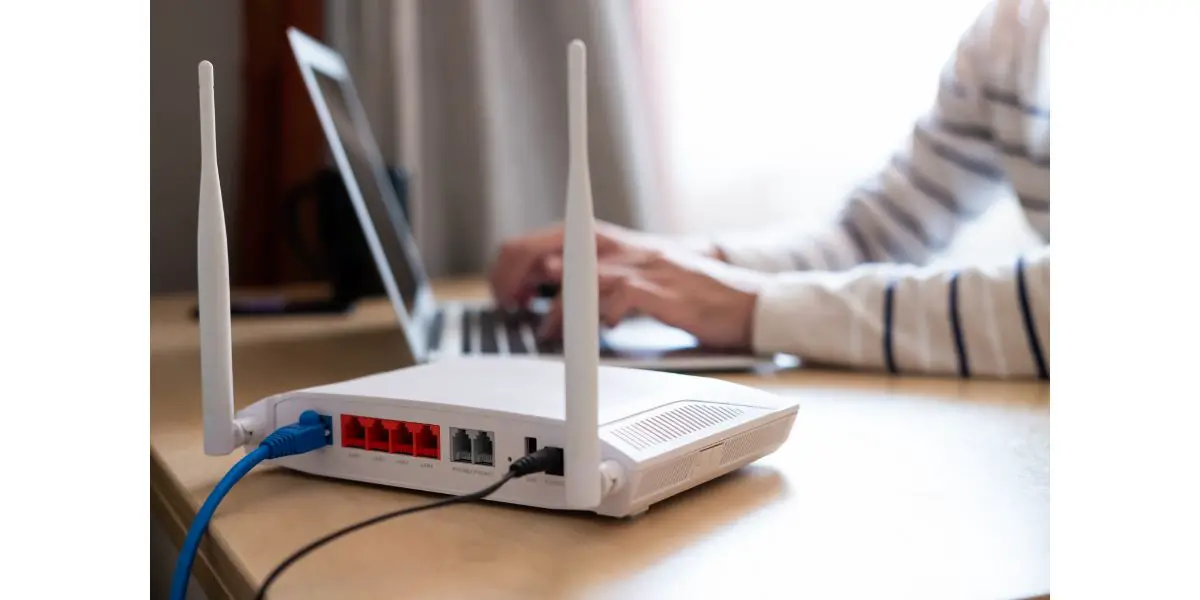Disclaimer: This post may contain affiliate links, meaning we get a small commission if you make a purchase through our links, at no cost to you. For more information, please visit our Disclaimer Page.
You often hear the word bandwidth to describe the quality of your internet connection. But what does bandwidth mean? People often assume it is synonymous with internet speed but is it correct?
Table of Contents
The Relationship Between Bandwidth and Internet Speed
Bandwidth is a crucial factor that affects internet speed. Many people use the highway analogy when explaining how bandwidth affects internet speed.
If your internet connection were a highway, bandwidth would represent the number of lanes, and the cars would be the data.
Understandably, the more lanes a highway has, the more cars can pass through it. Fifty cars can go through a ten-lane highway pretty quickly, but if there are only two lanes, it will take longer. The number of lanes is essential to the speed at which cars move on the highway.
What Exactly Is Bandwidth?
Bandwidth is the maximum volume of data that you can transfer in one second over an internet connection. A bandwidth of 50 Mb per second means that the largest amount of data your internet connection can handle in one second is 50 Mb; more than that, you would need more seconds to transfer the data.
Let’s say you have an internet connection with pretty good bandwidth and use it to watch a video. As someone in your house connects to watch another video and another goes to make a video call, you may notice that your video might load more slowly.
A slower or lower-quality connection means the amount of data you intend to transfer is beyond the bandwidth’s capacity. As a result, the information needs more time to reach your device. A more sizable bandwidth would allow more people or apps to use the same connection without changes in quality.
Are Speed and Bandwidth the Same Thing?
Bandwidth and internet speed are not the same thing, although people use the terms interchangeably. Speed is the rate at which data transfers through an internet connection. Bandwidth refers to the maximum amount of data you may transfer in an internet connection measured in megabytes per second.
Although essential, bandwidth is only one of the indicators of how fast a connection can be.
Other Factors That Affect Internet Speed
Several factors can affect the speed at which data reaches your computer or other devices. As you can deduce from what we’ve explained, the number of users affects internet speed. Other factors include the following:
Type of Connection
Some connections are inherently stronger and faster than others. In addition to the bandwidth, the connection type can significantly affect how fast you can transfer data from the web to your device.
Typically, cable connections are more robust and faster than WiFi connections. An ethernet cable ensures a speedy connection, sending and receiving data much faster than WiFi. Additionally, an ethernet connection is much more stable and safer.
Type of Hardware
You can access the internet using various devices, like PCs, laptops, phones, tablets, and more. Every single device is different regarding how it supports an internet connection, so you may find that the same internet connection can be slower or faster on other devices.
Some computers or other devices use older technologies that may affect how you transfer data. Old wireless cards or adapters can’t support the same speed as the newer models. If you’re looking for the best performance, choose a device that uses the latest technology.
Type of Accessories
If you’re using an ethernet cable for a faster connection, you should know that the cable type you’re using also makes a difference in the quality and speed of your connection.
Lower-quality cables won’t support the same rate as high-quality cables.
Always aim to buy the best possible accessories for a high-speed internet connection and ensure your cables last longer.
Your Location
Location is critical to your internet connection in more ways than one. Often, you may find that your internet connection may be faster or slower according to your proximity to your provider’s coverage area.
Additionally, the location of your router makes a significant difference if you’re using WiFi. The closer you are to the router, the better your connection will be. On the other hand, if you’re far away from the router or there’s a physical obstruction between you and the device, you may have a weaker and slower connection.
Factors That Affect Bandwidth
The bandwidth of your internet connection can be affected by several factors. If you have a slow connection, you may check these possible causes to see if there’s something you can do to improve the speed of data transfers in your device.
Multiple Devices Are Using Your Bandwidth
Your bandwidth is finite. Each device that gains access to your internet connection claims a part of the bandwidth, leaving less for the rest of the devices. Thus several users simultaneously using the same bandwidth will considerably affect your internet speed.
The Connection Prioritizes Downstream Bandwidth
In a typical connection, data flows from your device to the internet (upstream), and data also flows into your device (downstream). In most cases, users favor downstreaming data rather than upstreaming—which is why connections prioritize this flow direction.
However, there are times when you upstream more data than downstream, such as a video call. Because connections still prioritize the downstream bandwidth, allocating a smaller part of the bandwidth to the data going out. In these instances, you may be having issues with the speed of your connection.
Background Apps and Programs Use a Portion of the Bandwidth
Even though you may not notice it, plenty of background apps are running on your devices, like anti-malware programs, system updates, and more. Most apps need an internet connection to function. Thus, these apps may be using part of the bandwidth and slowing down your internet connection.
How To Check Your Bandwidth
Sometimes, you may experience connection issues and wonder if your bandwidth is more limited than usual. To know for sure if it’s a real issue, you can use a quick test on the internet.
All you need to do is find an online speed test. Yes, speed and bandwidth are different concepts, but these tests can give you a pretty good idea of the state and bandwidth.
These tests will download and upload a certain amount of data to their servers, measure how long the process will take, and then show you the results. Knowing your connection’s typical speed and bandwidth, you can tell if there’s a problem.
What To Do if Something Is Draining Your Bandwidth
When the bandwidth of your connection fails to meet your needs, you need to analyze all factors responsible for draining it. The first thing you need to do is check out all the factors that can affect your bandwidth or the general speed of your internet connection, as explained above:
- Number of devices
- Upstream vs. downstream bandwidth usage
- Background apps
- WiFi vs. Ethernet
- Hardware
- Accessories
- Location
These are the factors that are known to you and that you can control. Try to see if any of these factors is the culprit and if there’s something you can do about it, like reducing the number of devices using the same connection or changing the location.
However, you may still require more bandwidth even though all the above factors are in your favor. How is this possible?
There’s always the possibility that unknown devices are using your connection without you knowing about it. It can be malware installed on your computer or someone who has found a way to use your connection as they see fit.
Ways of Finding Out What Drains Your Bandwidth
Luckily, there are several different ways in which you can search for potential intruders that may be using your connection without your permission. Some of these ways are quick and simple, while others require more effort. You can start with the easiest ones:
Run an Anti-Malware Scan
Malware can enter your device and steal your bandwidth to communicate with an external server. To get rid of these unwanted viruses, you need to have an anti-malware program and run a scan on it. The program will find any malware installed on your computer and remove it.
Check your bandwidth using the test we explained above and see if you can spot a difference in the numbers provided. Additionally, keep using the internet to see if you’re having an easier time accessing information.
Track Your Bandwidth Usage
Your router tracks the outgoing and ingoing data transferred through your internet connection. If someone has found a way to access your connection, you can track them by their IP, device type, and connection status. To track every device using your bandwidth, follow these steps:
- Go to Router Settings.
- Find a list of all the devices using your connection.
- Check every device on the list and see if you can spot one that you don’t recognize and is consuming a lot of data.
- If you see an unfamiliar device, delete it from the list to stop it from accessing your network.
Use Windows Resource Monitor
As you can tell, you can only use this option if you have a Windows device. Resource Monitor is a diagnostic tool that shows you all the programs using your internet connection. You can easily use it by following these steps:
- Open Task Manager.
- Go to the Performance tab.
- Find the Open Resource Monitor at the bottom of the window.
- In the Overview tab, go to Network.
- Check out all the entries on the list and their respective usage statistics.
- It’s best to investigate unfamiliar programs using a lot of data.
- Check the program and uninstall it if needed.
Use Netstat
Netstat may seem like a more complicated method of finding out what’s slowing down your internet connection, but it’s relatively easy to employ. Netstat means Network Statistics and shows you all the active connections to your network. Here’s how to use it:
- Open an Administrator Command Prompt by pressing Windows + R to open the Run box and then type cmd on it to run the Command prompt (for Mac users, go to Launchpad on the dock and then type Terminal).
- The Command Prompt will open, waiting for your input.
- Write netstat -o and press Enter.
- A list of active connections will appear, along with statistics for each.
- See if you can spot an unusual entry on the list and investigate the IP address to learn more about it.
- You can also enter the address on a third-party website that can give you more information about who is using it.
- Optionally, you can use the PID on Netstat by finding it on the services tab of your Task Manager. If you don’t recognize it, stop the service.
Use a Third-Party Network Analysis Program
Some programs can show you a detailed analysis of your internet connection. You need to download the program and allow it to identify all devices. Once you see an unknown device, you can choose what to do with it.
Our best picks for third-party analysis programs include the following:
Netspot
Netspot is a free analysis tool for wireless site surveys. The app provides high-quality and precise WiFi analysis and troubleshooting on both Windows and Mac OX S. Netspot offers an easy-to-use wireless site survey to alert users to channel interference and dead zones. This professional app will help you build an effective and solid network.
SolarWinds
SolarWinds Network Bandwidth Analyzer Pack offers a handy tool for analyzing and diagnosing network performance issues. The comprehensive pack includes Network Performance Analyser (NPM) and Netflow Traffic Analyser (NTA) to cover all your bases. Solar Winds provides an excellent tool to monitor your network bandwidth performance and isolate bandwidth hogs that may slow your internet speed.
Conclusion
Bandwidth and internet speed are not synonymous with one another but are connected. The bandwidth is the maximum amount of data you can transfer in one second through an internet connection. The bigger your bandwidth, the easier it is for your system to transfer large amounts of data.



